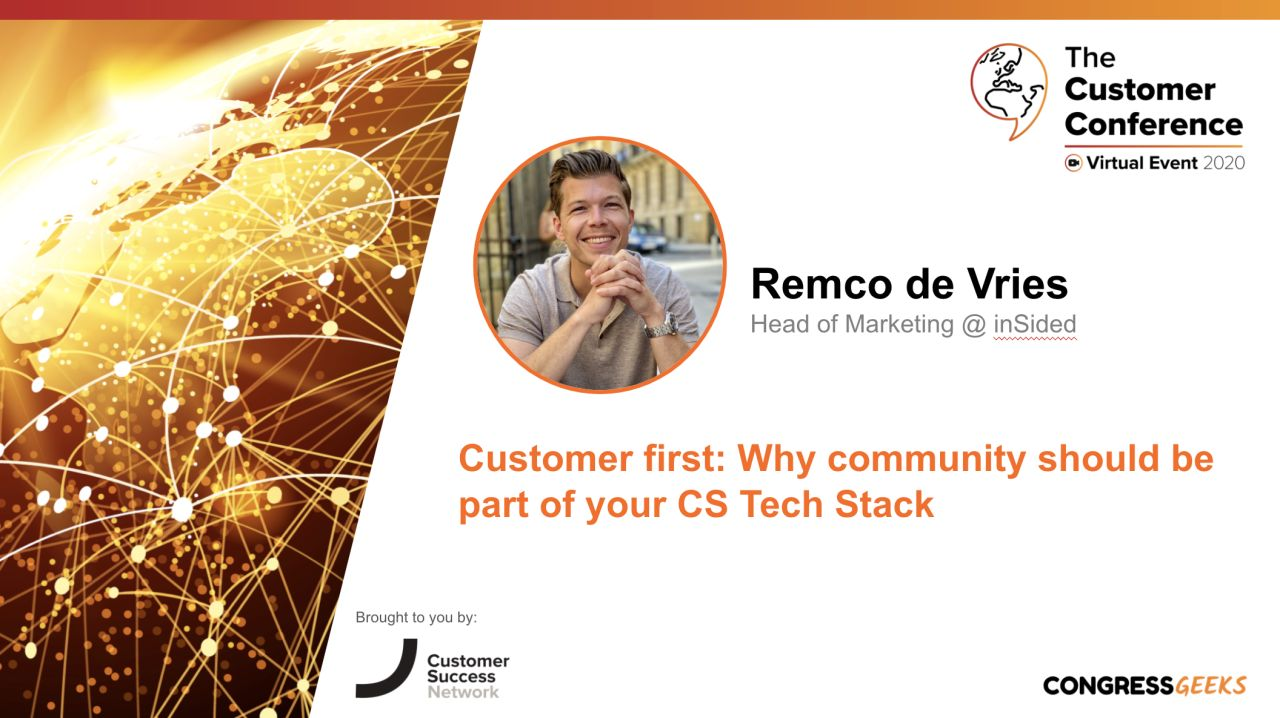Community helps solve for key CS challenges, saves time and resources through customer self-service, builds customer engagement and advocacy, and efficiently scales product feedback and communication.
Whether you attended the Customer (Success) Conference or not, we’re here on the inSided blog to detail our take on the event, and to answer the questions YOU asked during our sessions.
This year’s Customer Conference was completely virtual. We must admit that seems like a daunting task, but the organization led by Congress Geeks did a great job!
inSided was lucky enough to be the title sponsor, therefore we had two opportunities to speak: a thought leadership session and a demo-session. In this blog we’ll try and cover the main points from the first.
Community should be a central part of the Customer Success technology stack
We all thoroughly enjoy talking about Reducing Churn, increasing Net Retention, NPS, health-scores, renewals, CAC and advocacy. Each and every one of those metrics is very important, but do they reflect what a customer REALLY wants from your Product, or Customer Success team?
We believe that they don’t. When asked, customers will mention that they rather:
- Look to gain the most value possible from your product
- Get help, when they absolutely need it
- Want to be inspired by their peers
- Want their product feedback to be taken seriously
While some of these customer needs eventually might be reflected through any of the aforementioned metrics, they start somewhere else; while engaging with your Customer Success team. So, if we take these basic customer needs and try to figure out what you, as a CSM, can do to meet them. It might look something like this:
- You want to build an awesome product for your customers
- You can provide self-service content & inspiration to help them out
- You can facilitate engagement between the company and your customers
- You can more effectively collect feedback, and close the loop
For us at inSided this matters. This is exactly where a Customer Success Community Platform adds value; at the intersection of customer- and company interests, to drive value for both parties.

How a Customer Success Community helps you scale
Whilst working with amazing brands in B2B & SaaS, we started to notice a pattern when it comes to Customer Success team maturity and technological requirements. Customers and Customer Success teams alike, both go through phases of growth. We distinguish four phases:
- Exploration
You’re a small support focussed team. There aren’t many customers yet, so any dealings you might have with them happen over the phone or email, and it’s still easy to be proactive about making sure they are achieving the maximum value from your product(s) - Building
As your customer count increases, so does the need for focus on high-value conversations v.s. simple repeat questions. In this phase you start structuring Q&A, by building a Knowledge Base, chat or ticketing system. - Accelerating
Customers start pouring in, and you find your team completely stretched for time and resources. There’s a massive influx of customer questions, product feedback & other tasks, that seem unscalable by hiring more CSM’s alone. You’re launching a CRM for better insight, and add a Customer Success Community to centralize CS content, gain peer-to-peer support and structure Product Feedback. - Scaling
There are now so many customers that it’s hard to focus on the right value-adding conversations. You need to prioritize, and you need to be more efficient with resources. In order to stay proactive, you’re looking into centralizing customer data, integrations with other tooling in your tech-stack and automation of certain customer flows.
We have visualized this journey in our Customer Success Maturity model:

To deal with these challenges, purpose-built technology for Customer Success starts becoming more and more important.
There are three ways a Customer Success Community solves these challenges.
1. Save time and resources through Customer Self-service
We all try to build our products in such an intuitive way that customers can use them without friction, right? However, customers will always have questions, there’s no avoiding that.
There’s a simple opportunity to answer the most common questions without getting your CS or Support team(s) involved: self-service. For example a customer driven Knowledge Base, or a Customer Success community. At least a central place for all Customer Success content that customers might need to use your product.
And then there’s peer-to-peer support. We don’t want to breathe new life into the phrase: “Wisdom of the Crowds”, but your customers combined know a lot more about your product than you think. Offer them an easy way to connect, help, and share best practices and you’ll directly notice that in time & resources saved.
Btw, we are often asked: “Will my customers actually make time to help each other”? Yes. They will. We have seen that proven time and time again.
2. Customer Engagement and Advocacy
Increase retention? Yes, please. And let’s increase NPS, create advocates, increase upsell and customer happiness too while we’re at it. But.. how?
We can stare at customer retention numbers all day, but being a lagging metric that won’t change anything. Content is the solution here. We have grown accustomed to content being the solution when it comes to Marketing, or Demand Generation. But, whenever we position content as a potential driver for engagement and retention we get looked at in a funny way.
By actually engaging and inspiring customers with relevant content, you can increase engagement and through that Product Adoption and eventually Retention. Why not create howto’s, educational content, customer stories and product updates with a clear CS driven goal. After which you centralize all of that content in the Customer Success Community Platform, for easy access by any customer.
Or go one step further, and engage exceptionally active customers in your community to create & publish content for you. Give them a special ‘role’ that also is a testament to the effort they are putting in, and continue to engage them for references, customer stories, etc.
3. Efficiently scale Product Feedback & Communication
Finally, an age-old struggle in Customer Success. Customer feedback, and the translation of that feedback to the Product Team. This one hurts! There are so many things that can go wrong here, which are all directly impacting the relationship with the customer. For example:
- Customer feedback that’s lost, due to inefficient ways of storing it
- A customer feature request that’s ignored by product
- Feature request that are not centralized, and thus hard to retrieve
- Manually kept spreadsheets filled to the brink with feedback & requests
In the early days of inSided, our CSM’s actually kept a spreadsheet per customer. Imagine rolling up to the Product Team, and having to go through all of those spreadsheets, trying to figure out if requests should be prioritized or trying to find similarities between customer requests. It just doesn’t work. Even having individual CSM’s discuss individual feature requests with Product is a struggle, and you should even consider whether or not it’s the best use of their time when they are talking to customers.
So, when we introduced our own Customer Community, we created a central location for all customers to ask product questions and give product feedback. Customers can submit all of their wishes, and other customers can vote on those ideas if they have a similar request, or help customers understand how to do things in your product if the feature already exists.
Even more powerful: customers will help you qualify requests, by voting on them or dismissing them. Or you could integrate with e.g. Salesforce to find out how much ARR (counted by the customers that voted) is backing a specific feature request to help you make an internal business decision.
Last but not least, when you finally decide to build a community-suggested feature, you have all the tools to close the loop and let your community know that it has been built—eventually leading to more adoption.
Want to learn more? Get a copy of our Customer Success Technology Stack eBook, or get in touch on our Community.


